Toronto, a diverse and tech-savvy metropolis, is known for its vibrant culture, thriving economy, and robust educational institutions. However, beneath the surface of this bustling city lies a digital divide—a gap in internet access and digital literacy that affects many of its residents. In response to this challenge, community initiatives are leveraging public WiFi heatmaps to bridge the digital divide in Toronto, ensuring that all residents have equitable access to the benefits of the digital age.
Understanding the Digital Divide
The digital divide is a complex issue that encompasses disparities in internet access, digital skills, and the ability to harness the opportunities offered by technology. While Toronto enjoys a well-developed digital infrastructure, not all residents have equal access to the internet or the knowledge to use it effectively.
Key factors contributing to the digital divide in Toronto include:
- Economic Disparities: Low-income households often struggle to afford internet connections and the devices needed to access the web.
- Geographic Barriers: Certain neighborhoods, particularly those in remote or underserved areas of Toronto, may have limited access to high-speed internet.
- Digital Literacy: Some residents lack the digital skills necessary to navigate online resources, apply for jobs, or access educational materials.
- Access to Devices: Even if internet access is available, not everyone has access to computers or smartphones.
The Role of Community Initiatives
Community organizations and local governments in Toronto recognize the importance of addressing the digital divide as part of a broader effort to promote equity and inclusion. These initiatives aim to ensure that no one is left behind in the digital age.
One approach that has gained traction is the deployment of public WiFi networks in underserved neighborhoods and community centers. These networks offer free or low-cost internet access to residents and visitors. However, deploying public WiFi is just the first step; optimizing its coverage and usability is equally crucial.
WiFi Heatmaps: Optimizing Public Connectivity
Public WiFi heatmaps in Toronto have emerged as a powerful tool in the effort to bridge the digital divide. These heatmaps visualize the strength and coverage of WiFi signals in public areas, helping organizations fine-tune the deployment of access points for maximum reach and reliability.
Here's how WiFi heatmaps contribute to community initiatives:
- Identifying Dead Zones: WiFi heatmaps help pinpoint areas with weak or no connectivity, enabling organizations to strategically place access points where they are needed most.
- Optimizing Access Point Placement: By analyzing the data provided by heatmaps, community organizations can make informed decisions about where to position access points for optimal coverage.
- Managing Interference: Heatmaps reveal areas where signal interference might disrupt connectivity. This information allows for the adjustment of network configurations to minimize interference.
- Ensuring Equity: WiFi heatmaps help ensure that public WiFi networks reach all corners of the community, addressing the geographic disparities in internet access.
Benefits for Residents
For Toronto residents, the benefits of community initiatives supported by WiFi heatmaps are substantial:
- Affordable Access: Public WiFi networks provide a cost-effective means of accessing the internet, reducing the financial burden on low-income households.
- Education and Skills Development: Free access to online educational resources and digital skills training programs enables residents to enhance their knowledge and employability.
- Community Engagement: WiFi-enabled public spaces encourage community members to gather, share, and collaborate, fostering a sense of belonging and social cohesion.
- Access to Services: Residents can access essential online services, such as government resources, healthcare information, and job listings, improving their overall quality of life.
Local Initiatives Making a Difference
In Toronto, various local initiatives have leveraged public WiFi heatmaps to make a positive impact on bridging the digital divide:
- Libraries: Toronto Public Library branches have deployed public WiFi networks with optimized coverage, providing free internet access to patrons.
- Community Centers: Many community centers in underserved neighborhoods now offer public WiFi as part of their services, promoting digital inclusion.
- Public Spaces: Parks, plazas, and public squares are increasingly equipped with WiFi to create connected gathering spaces for residents.
Community initiatives supported by public WiFi heatmaps are playing a pivotal role in bridging the digital divide in Toronto. By optimizing the deployment of public WiFi networks, these initiatives ensure that all residents, regardless of their economic circumstances or geographic location, have equitable access to the internet and its benefits.
As Toronto continues to evolve as a global city, its commitment to digital inclusion reflects its dedication to equity, diversity, and the well-being of its residents. By leveraging technology and community-driven efforts, Toronto is actively working to create a more inclusive and connected future for all its residents, regardless of their digital backgrounds or access to resources.


No comments yet